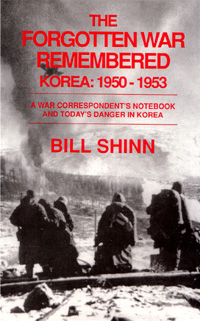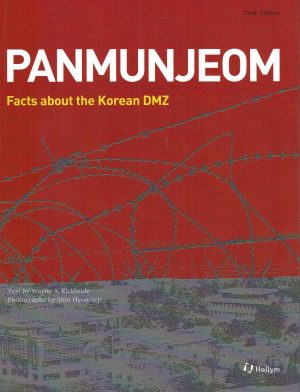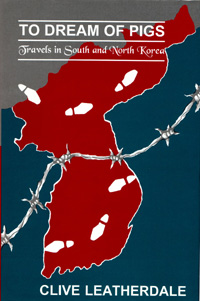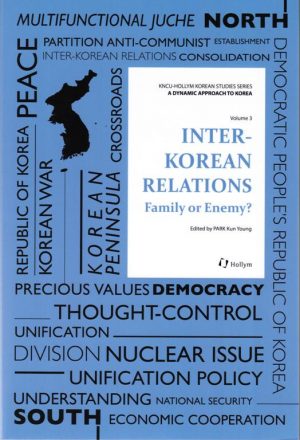Forgotten War Remembered, Korea
$24.50
The Forgotten War Remembered reminds us that the precarious Korean Peninsula equation is the most dangerous piece of unfinished foreign policy business confronting the United States in Asia. Author Bill Shinn conveys his eyewitness accounts from the battlefield as an Associated Press correspondent along with incisive analysis of North Korean strategy to provide the best and most comprehensive book in print on the Korean question. Includes the key “China factor.”
Review:
An excerpt from The Journal of Asian Studies, 57:1 (February 1998): 156-160
Bill Shinn’s Korean War: the Forgotten War Remembered is a former Associate Press war correspondent’s recollection, primarily of the Korean War. Shinn begins his book with a personal narrative of his youth during the Japanese colonial and the American Military Government periods. His firsthand experiences are interwoven throughout the book with descriptions of the major events of the war. Shinn’s book thus provides perspectives of a Korean civilian, who was also an international news agency reporter with an exceptionally adroit ability to “scoop” stories before anyone else (hence, a nickname, Scoop Shinn) and with opportunities to access several most highly positioned Korean and non-Korean military and civilian personnel. This unusual combination of circumstances enabled Shinn to share with the reader a few first-person accounts that previously have not been widely known.
Despite its nickname as the “forgotten” war, some stories of the Korean War are familiar—the fleeing refugees, the panicked American and South Korean troops, the shameful retreat to the Pusan perimeter, MacArthur’s brilliantly executed landing at Inchon, the capture of the North Korean capital of Pyongyang, the retreat from the Yalu, the counter offensive, the peace talks at Kaesong and Panmunjom, Little Switch and Big Switch (of POWs) and eventually peace. All these have been told and retold, studied and researched by journalists, scholars, and people in all ranks of government and the military. But most have been told with minimal inclusion of Korean elements except, of course, the ragged refugees and the devastated land in unbearably harsh weather, so that the tales of the Korean War might as well have been those of a war that happened to be fought on the Korean soil—not necessarily those of the “Korean” War.
Shinn’s book remedies the situation. As a Korean-born reporter, he does not “forget” to include points that are important to South Korean sensibilities and thus bring balance to the account of the war: the South Korean army’s roles at several critical junctures of the war, such as the Inch’on landing (p. 113); the jubilant gathering at the capture of Pyongyang; the Korean chagrin for a lost opportunity for reunification when the northward march was abandoned and MacArthur was relieved of his command; the anguish for the stalemated, on-again and off-again peace talks; and the South Korean sense of betrayal at the secret U.N. proposal regarding the anti-Communist prisoners. Shinn’s account of the last of these, the U.S. compromise on the POW issues, is the first in the Korean-War literature. No one other than someone in Shinn’s position could have revealed the background of one of the most controversial events of the Korean-War period, President Syngman Rhee’s unilateral release of 27,000 anti-Communist POWs on June 18, 1953. Scoop Shinn discloses the “scoop” that was obtained from a young Korean press officer under the U.N. Command. In an attempt to achieve armistice as soon as possible, the U.N. Command submitted a secret proposal to the Communists that contained further concessions to the Communist demands and the provisions more disadvantageous to anti-Communist POWs than previous recommendations. Certain of South Korean objection, the U.S.-led U.N. Command withheld the plan to yield to the communists’ demands from Major General Choi Duk-shin, the highest-ranking South Korean attending the Panmunjom talks, until one hour before the meeting. General Choi boycotted the meeting, but the U.N. Command and the Communists proceeded to sign an agreement, which among others, extended the released POWs’ period of explanation (a waiting period before returning home) from sixty to ninety days, on the repatriation of prisoners of war on June 8, 1953.
Shinn’s dispatch to the Associate Press on the secret U.N. proposal made headline news in South Korean newspapers and led to the South Korean National Assembly’s unanimous resolution to oppose the proposed truce terms and to anti-armistice demonstrations throughout South Korea. This news was the last straw to South Korean President Syngman Rhee, who had vociferously opposed the truce without unification from the beginning of the talks and who had made the disposition of anti-Communist prisoners his personal crusade. Rhee, who had felt betrayed, resolved to take action: just after 2 A.M., on June 18, he ordered South Korean guards to open the anti-Communist POW camp gates in Pusan, Kwangju, Nonsan, Masan, and Taegu, and a total of 27,000 anti-Communist POWs were released and disappeared into the general population (pp.217-24). Shinn believes that the world community misplaced diatribes—not at the U.S., for presenting a secret proposal to the Communists, but at Rhee, who was severely criticized for his “impetuous” action and was called ungrateful and treacherous.
Shinn’s book does not conclude with the cessation of the hostilities for the two Koreas. As he correctly observes, the war never ended. In the final section, entitled “Potential Flashpoint,” Shinn summarizes his personal assessment of the current political situation: he considers the mere cease-fire—not the conclusive peace—resulted in the long-term hostile standoff between the two Koreas, turning South Korea into a society under siege by subversion, guerrilla, and terrorist operations launched by North Korea. Shinn cautions the U.S. to remember in its dealings with North Korea, obviously keeping in mind the recent negotiations over nuclear issues. He ends the book with a speculation on Korean reunification about which he is cautiously optimistic, but he also concedes that none of Korean’s neighbors are overly eager to see Korea united any time soon. This book will add a South Korean perspective to the growing body of literature on the Korea War, still dominate by non-Korean interpretation.
Bonnie B. C. Oh
Georgetown University




